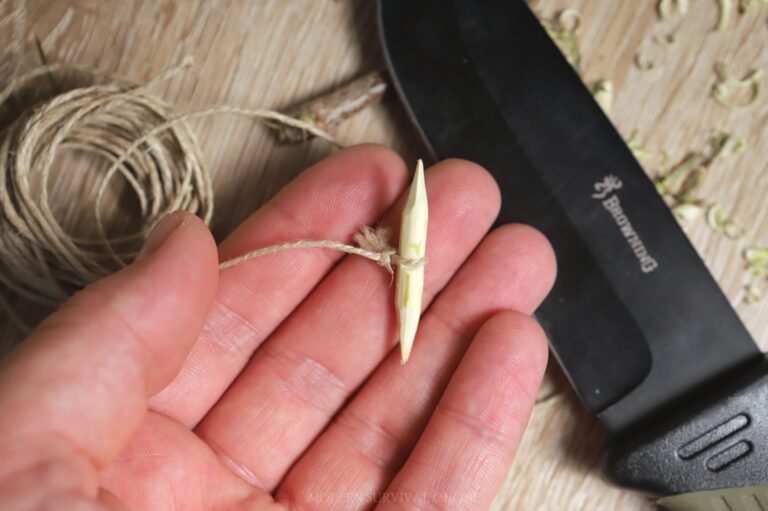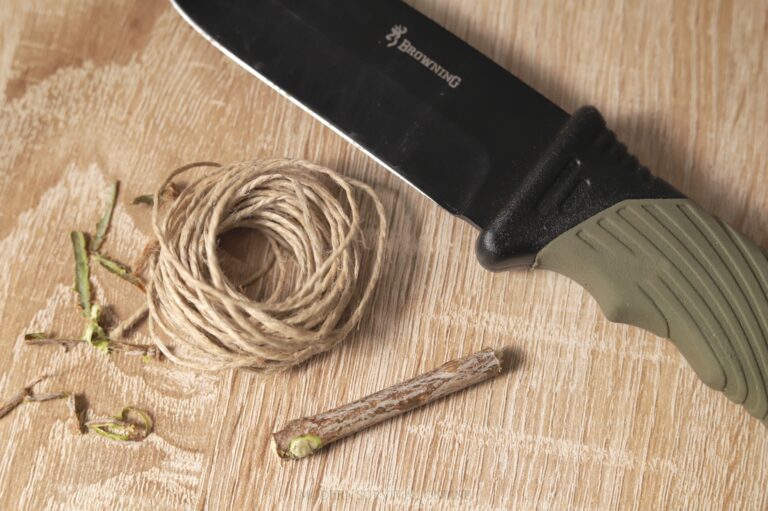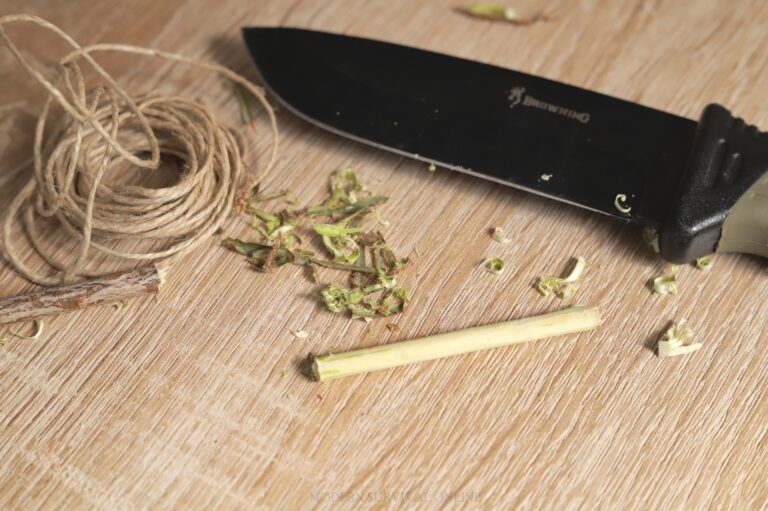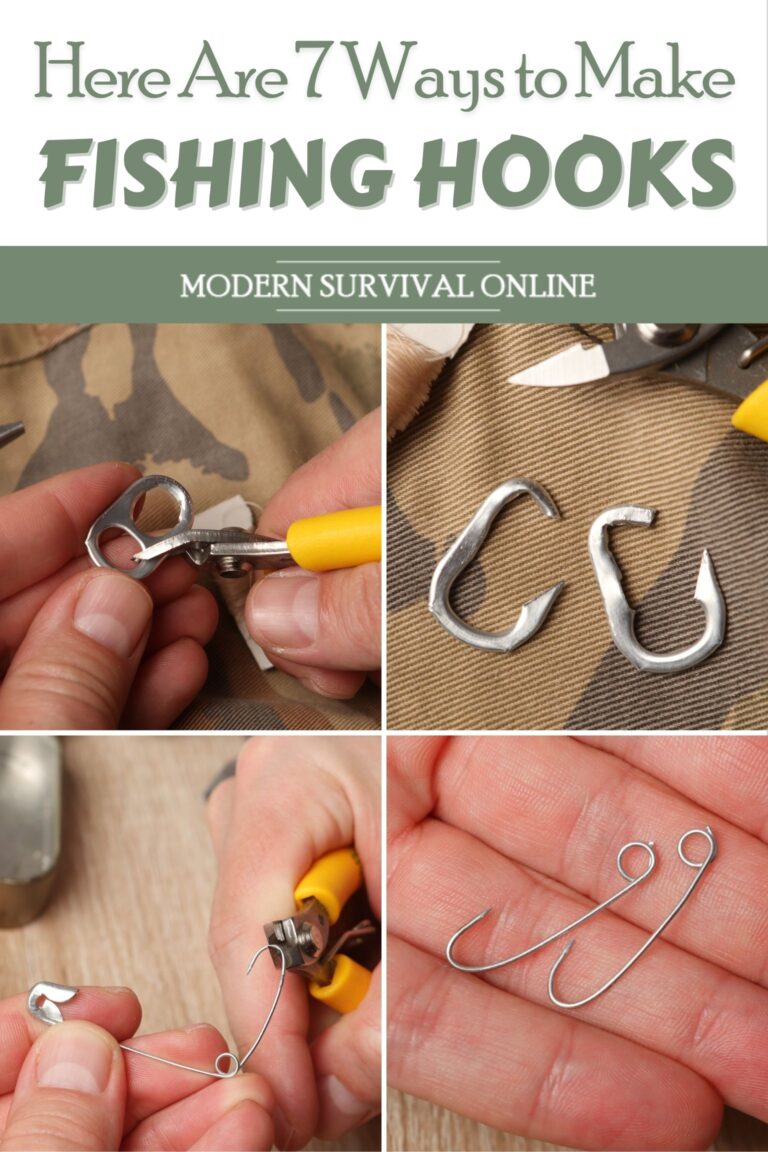In any wilderness survival situation, obtaining food is a priority. Though you can stay alive for weeks without any food, you’ll become so mentally and physically degraded your chances of survival will dwindle every day that you do not eat.
Naturally, many folks include hunting and trapping gear in their survival kits for the purpose, but both activities require a ton of skill, and more than a little luck.
A better option, if you are anywhere with a sizable body of water, is fishing. Fish are easy to catch with a little bit of know-how, and it is a lot easier to craft improvised fishing gear from natural and man-made materials than weapons suitable for bringing down large or small game.
The list below has 10 improvised fishing hook designs that are guaranteed to put a fish over your campfire.
1. Soda Can Tab Hook
Far and away my favorite design on this list. Soda can tabs are perfect for fashioning into hooks since they are a rolled and stamped metal design that is extremely rigid and tough for its size and weight.
For our purposes, the preponderance of litter around the world means that you’ll probably only have to look around a little while until you find an old crumpled beer or soda can that you can harvest the tab from.
As long as you find an intact tab, you’re in business. Do the following:
1. Free the tab from the can without damaging or bending it. Usually you can pry it off at the attachment point with little trouble.
2. Using nippers, a chisel, a knife, a sharp rock or anything else that can cut the metal of the tab take out one side of the larger opening in the tab, leaving the rounded part in the shape of an uppercase J.
3. File or cut the short end of the opening into a sharp angle, creating your point.
4. Take the time to file off any burrs or other sharp edges on the opposite end of the tab so it does not fray or cut your line.
5. Now simply tie on your newly created hook using the small opening in the opposite end of the tab.
6. Bait your hook as normal, and then cast.
2. Safety Pin Hook
This is another tried and true method in a prepper’s toolbox. The durability, springiness and design of safety pins means they are easily repurposed into quality fishing hooks and they are easily strong enough to catch a decent sized fish.
My favorite part about this method is that absolutely no tools whatsoever are required, except perhaps a sturdy, small object that can help you bend one end of the open pin.
Grab a safety pin, and then do the following:
1. Open the pin.
2. Bend the free end outward until it protrudes at roughly a 45 degree angle from vertical.
3. Using your fingers or a smooth tool, gently curve the free end of pin into a classic hook shape.
4. Tie your new hook onto the line using the loop at the opposite end of the hook.
5. Bait and cast as normal.
3. Sewing Needle
Sewing needles are also a nice base metallic object to use for hook crafting. But compared to safety pins, you’ll have a little more work to do, and will struggle a bit more to get your line threaded, especially if it is larger or the sewing needle is very small.

In my experience, larger sewing needles with more generous eyes work best. Grab the needle (not by the sharp end, hopefully) and then do the following:
- Using your fingers, or with a sturdy small diameter round tool, gently bend the sewing needle into a hook shape.
- Ensure that you don’t damage or bend the point while shaping the hook.
- Using eyelet on needle fasten to line.
- Bait and cast.
Another interesting thing you can do is sewing needles and a little bit of extra cordage or adhesive is to tie a group of them together into a multi-pointed hook.
This may or may not be necessary depending on what you were fishing for, but it’s nice to know you can do it.
4. Wood Hook
Believe it or not, you can use wood to make a very serviceable fishing hook. Historically, wood has been used on all kinds of hooks, and you can do the same thing.

There are two basic approaches to making wood hooks, detailed below:
Method 1
- Find a small sturdy stick about 3 inches long.
- Cut off one inch from this stick.
- From the shorter piece you broke off, peel off the bark and then sharpen it into a fine point.
- Peel the bark from the remaining larger piece of the stick.
- If able, drill a hole through one end of the longer piece, or alternately carve notches on either side of one end. This will be used to attach your line.
- Use cordage and lash the sharpened point to the base of the longer piece with the hook sticking up at an angle.
- Tie your newly made hook to your line.
- Bait and cast.
Method 2
- Find a small branching stick that is two to three inches long.
- Remove the bark, and then cut down the smaller branching fork into a length suitable for a hook.
- Sharpen this forked part into a point.
- Drill a hole into the farther end of the longer part, or put a notch in either side as a detailed in the previous method for tying line.
- Tie on normally.
- Bait, cast, and hope for the best.
5. Wood Gorge
Hooks aren’t the only way to catch a fish; you can easily fashion a gorge from all sorts of materials.
Gorges, sometimes called gorge hooks, are an ancient design that can still catch fish today. The trick is that the size of the gorge hook must be properly sized for the type of fish you’re catching.

small gorge hook in hand
If the gorge is too large, smaller fish won’t even make an attempt on it. Too small, and larger fish won’t be caught. Luckily, it is easy to quickly craft a variety of sizes. Use the following steps:
Step 1. Find a sturdy stick or branch that can be easily cut down to size. The stick should be anywhere from a ¼ to ⅜ of an inch thick depending on the size of the fish you’re trying to catch. Bigger fish need a larger stick.

string knife and small piece of wood
Step 2. Strip all bark from the stick.

wooden gorge hook stub with shaved bark
Step 3. Sharpen both ends of the stick into a pronounced, tapering point.
Step 4. Carefully carve or sand a groove around the middle of the stick, all the way around. This is where you will attach your line.

cutting a notch into a small gorge hook
Step 5. Tie the hook onto your line so that it’s held parallel with the line when in the water.
Gorge hooks work by lodging in the throat of the fish after they swallow the bait and the gorge in the bargain.
When tension is applied after swallowing, the gorge will rotate and become stuck in the throat of the fish, allowing you to reel it in.
6. Thorn Hook
You might not have to work very hard at all to fashion a fishing hook if you start with a natural hook shape.
Choosing a live, sturdy thorny branch clean off as many thorns as necessary. This is it easily and quickly done, and you can catch fish that are proportionate to the size and strength of the thorns.
Do the following:
- Snap off a short length of a thorny branch.
- Clean off as many thorns as necessary to allow for tying. Make sure to leave the most prominent and strongest thorn in place to serve as the actual hook.
- Whittle a groove, or drill a hole around the opposite end in the branch farthest from the remaining thorn. Use this for tying on your line.
- After tying, bait the thorn as normal, and then cast.

Many species of thorny plant are surprisingly tough and flexible when live, and they make great fish hooks, though they don’t last very long.
The good news is you can probably easily find more where those came from with a little bit of time!
This method is great if you live in a place that has abundant thorny foliage, and plants with large, impaling thorns are some of the best for larger fish.
7. Bone Hook
Bone is another classic material for fashioning fishing hooks, and one that has been used for ages. If you’re able to scavenge any bones from dead animals in the area, or just have leftovers from a successful hunt, use them to make some really nice hooks with a little carving.

You want to use raw, uncooked bones for the purpose since they are stronger than cooked bones. Try the following:
- Locate a bone that looks like a wishbone, something similar to a forked branch.
- Choose one limb of this bone and break, or cut it off in a length that is appropriate for fashioning a hook.
- Carve and sharpen the short end of the fork into a point. Once this is done, you can improve effectiveness by carving a notched barb into the interior surface just behind the point.
- Now either drill a hole or carve notches in the far end of the long leg to serve as your attachment point for your line.
- Tie on your line as normal.
- Bait, cast and be patient!
As a material, bone has some advantages when it comes to durability while also being fairly easy to work with just a few tools.
The extra time you spend fashioning a bone hook can pay off in the ability to more reliably land fish.
Also note that you can use bone hooks to make gorges as described above. You’ll follow the exact same steps that you would for crafting one from wood, so refer back to that section.

By: Tim Makay
Title: Here Are 7 Ways to Make Fishing Hooks
Sourced From: modernsurvivalonline.com/diy-fishing-hooks/
Published Date: Sat, 25 Mar 2023 13:30:00 +0000
-------------------------------------------------------------------------
Did you miss our previous article...
https://outdoorsnewswire.com/survivalist/so-can-you-eat-salamanders-for-survival
 CampingSurvivalistHuntingFishingExploringHikingPrivacy PolicyTerms And Conditions
CampingSurvivalistHuntingFishingExploringHikingPrivacy PolicyTerms And Conditions
